cruise control OPEL CORSA F 2020 Manual user
[x] Cancel search | Manufacturer: OPEL, Model Year: 2020, Model line: CORSA F, Model: OPEL CORSA F 2020Pages: 229, PDF Size: 21.14 MB
Page 130 of 229

128Driving and operatingstart moving. Be always prepared
to manually apply the brake to hold the vehicle stationary.
Do not leave the vehicle while it is being held at a stop by adaptive
cruise control. Always move
selector lever to park position P
and switch off the ignition before leaving the vehicle.
Setting the following distance
When adaptive cruise control detects a slower moving vehicle in the driving
path, it will adjust the vehicle speed to maintain the following distance
selected by the driver.
The following distance can be set to
close (1 bar), normal (2 bars) or far (3 bars).
If the engine is running and the
adaptive cruise control is enabled
(grey) or avtive (green), you can
modify the following distance setting:
Press V, the current setting is
shown in the Driver Information
Centre.
Press V again to change the
following distance: The new setting is displayed in the Driver Information
Centre.
The selected following distance is
indicated by full bars in the adaptive
cruise control page.9 Warning
The driver accepts full
responsibility for the appropriate
following distance based on traffic, weather and visibility conditions.
Following distance must be
adjusted or the system switched
off when required by the prevailing
conditions.
Detecting the vehicle ahead
If the system detects a vehicle in the
driving path, the adaptive cruise
control symbol displayed in the Driver
Information Centre changes: - is
changed to w.
Deactivation of the functionality
Press i, the adaptive cruise control
is in pause mode and a message is
displayed. The vehicle is driven
without adaptive cruise control.
The adaptive cruise control is
deactivated, but not disabled. The
last stored set speed remains in
memory for later usage.
The adaptive cruise control is
deactivated automatically in the
following cases:
● The brake pedal is depressed.
Page 131 of 229
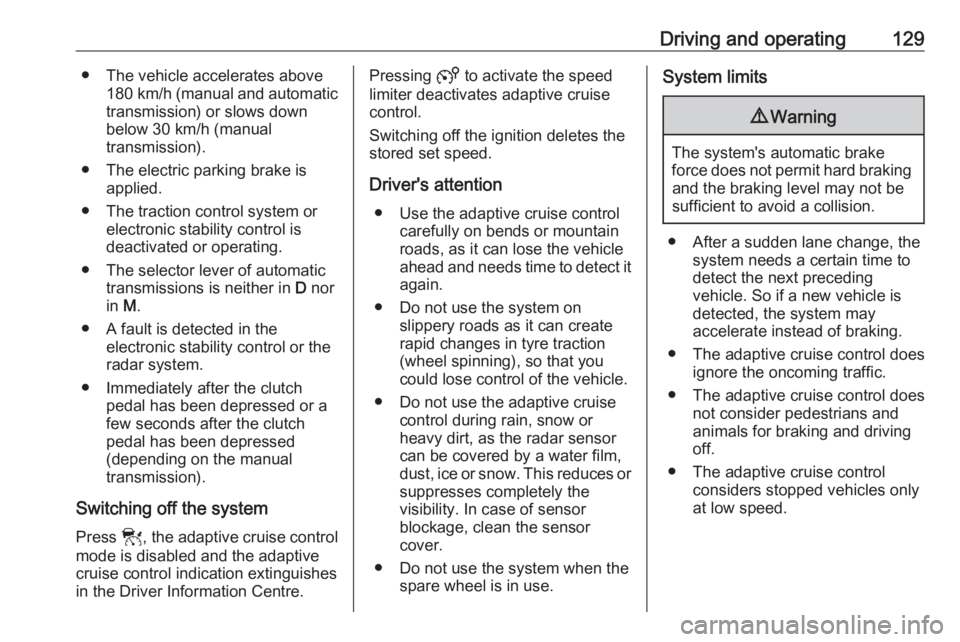
Driving and operating129● The vehicle accelerates above180 km/h (manual and automatic
transmission) or slows down
below 30 km/h (manual
transmission).
● The electric parking brake is applied.
● The traction control system or electronic stability control is
deactivated or operating.
● The selector lever of automatic transmissions is neither in D nor
in M.
● A fault is detected in the electronic stability control or the
radar system.
● Immediately after the clutch pedal has been depressed or a
few seconds after the clutch
pedal has been depressed
(depending on the manual
transmission).
Switching off the system
Press w, the adaptive cruise control
mode is disabled and the adaptive
cruise control indication extinguishes
in the Driver Information Centre.Pressing 5 to activate the speed
limiter deactivates adaptive cruise
control.
Switching off the ignition deletes the
stored set speed.
Driver's attention ● Use the adaptive cruise control carefully on bends or mountain
roads, as it can lose the vehicle
ahead and needs time to detect it
again.
● Do not use the system on slippery roads as it can create
rapid changes in tyre traction
(wheel spinning), so that you
could lose control of the vehicle.
● Do not use the adaptive cruise control during rain, snow or
heavy dirt, as the radar sensor
can be covered by a water film,
dust, ice or snow. This reduces or suppresses completely the
visibility. In case of sensor
blockage, clean the sensor
cover.
● Do not use the system when the spare wheel is in use.System limits9Warning
The system's automatic brake
force does not permit hard braking and the braking level may not be
sufficient to avoid a collision.
● After a sudden lane change, the system needs a certain time to
detect the next preceding
vehicle. So if a new vehicle is
detected, the system may
accelerate instead of braking.
● The adaptive cruise control does ignore the oncoming traffic.
● The adaptive cruise control does not consider pedestrians and
animals for braking and driving
off.
● The adaptive cruise control considers stopped vehicles only
at low speed.
Page 132 of 229
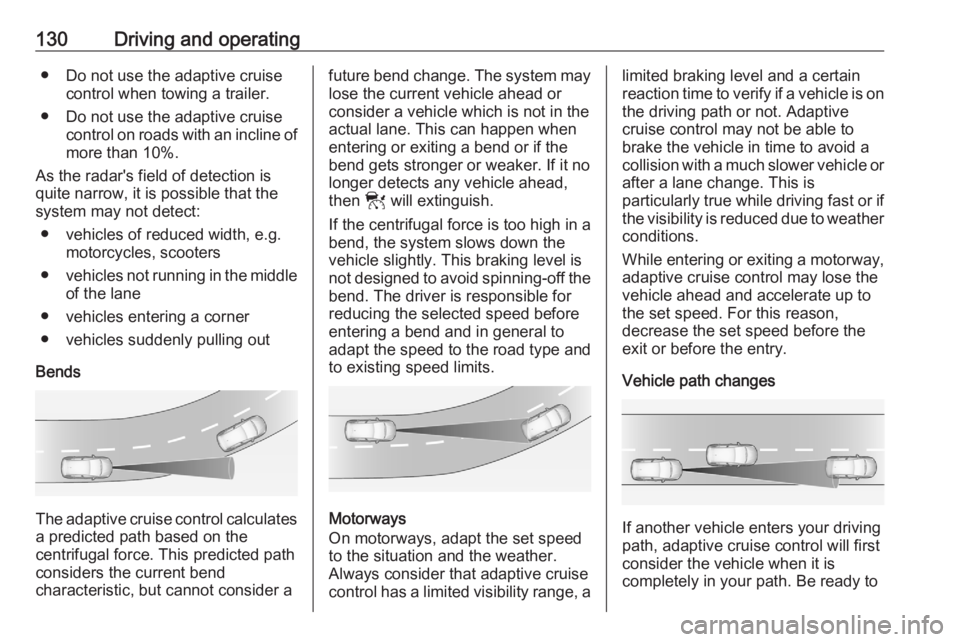
130Driving and operating● Do not use the adaptive cruisecontrol when towing a trailer.
● Do not use the adaptive cruise control on roads with an incline of
more than 10%.
As the radar's field of detection is
quite narrow, it is possible that the
system may not detect:
● vehicles of reduced width, e.g. motorcycles, scooters
● vehicles not running in the middle
of the lane
● vehicles entering a corner
● vehicles suddenly pulling out
Bends
The adaptive cruise control calculates
a predicted path based on the
centrifugal force. This predicted path
considers the current bend
characteristic, but cannot consider a
future bend change. The system may lose the current vehicle ahead or
consider a vehicle which is not in the
actual lane. This can happen when
entering or exiting a bend or if the
bend gets stronger or weaker. If it no
longer detects any vehicle ahead,
then w will extinguish.
If the centrifugal force is too high in a
bend, the system slows down the
vehicle slightly. This braking level is
not designed to avoid spinning-off the
bend. The driver is responsible for
reducing the selected speed before
entering a bend and in general to
adapt the speed to the road type and
to existing speed limits.
Motorways
On motorways, adapt the set speed
to the situation and the weather.
Always consider that adaptive cruise
control has a limited visibility range, a
limited braking level and a certain
reaction time to verify if a vehicle is on
the driving path or not. Adaptive
cruise control may not be able to
brake the vehicle in time to avoid a
collision with a much slower vehicle or after a lane change. This is
particularly true while driving fast or if the visibility is reduced due to weather
conditions.
While entering or exiting a motorway,
adaptive cruise control may lose the
vehicle ahead and accelerate up to
the set speed. For this reason,
decrease the set speed before the
exit or before the entry.
Vehicle path changes
If another vehicle enters your driving
path, adaptive cruise control will first
consider the vehicle when it is
completely in your path. Be ready to
Page 133 of 229

Driving and operating131take action and depress the brake
pedal if you need to brake more
quickly.
Hill considerations9 Warning
Do not use the adaptive cruise
control on steep hill roads.
System performance on hills depends
on vehicle speed, vehicle load, traffic
conditions and the road gradient. It
may not detect a vehicle in your path
while driving on hills. On steep hills,
you may have to use the accelerator
pedal to maintain your vehicle speed.
When going downhill you may have to brake to maintain or reduce your
speed.
Note that applying the brake
deactivates the system.
Radar unit
The radar unit is located in the middle of the front bumper.
9 Warning
The radar unit was aligned
carefully during manufacture.
Therefore, in the event of a front-
end impact, do not use the system. The front bumper may appear to
be intact, however the sensor
behind may be affected and react
incorrectly. After an accident,
consult a workshop to verify and
adjust the radar unit position.
9 Warning
The usage of a license plate
support may have an impact on
the proper operation of the radar
unit and may limit sensor
perfomance. Vehicles driving
ahead, pedestrians or other
objects located in front of the
vehicle may not be detected by the
system.
Do not use a license plate support on the front bumper to ensure
proper system functionality.
Fault
In the event of a fault with the adaptive cruise control, you are alerted by the
illumination of a warning light and the
display of a message in the
instrument panel, accompanied by an audible signal.
The adaptive cruise control may not
operate correctly if traffic signs do not
comply with the Vienna Convention
on Road Signs and Signals.
Have the system checked by a dealer or a qualified workshop.
Page 140 of 229
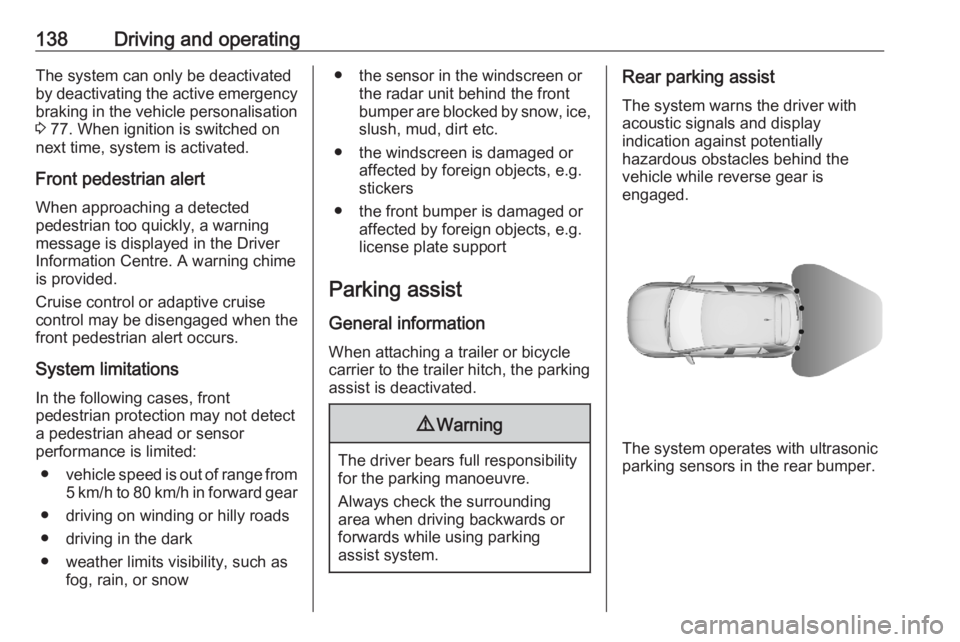
138Driving and operatingThe system can only be deactivated
by deactivating the active emergency braking in the vehicle personalisation
3 77. When ignition is switched on
next time, system is activated.
Front pedestrian alert
When approaching a detected
pedestrian too quickly, a warning
message is displayed in the Driver
Information Centre. A warning chime
is provided.
Cruise control or adaptive cruise control may be disengaged when the
front pedestrian alert occurs.
System limitations
In the following cases, front
pedestrian protection may not detect
a pedestrian ahead or sensor
performance is limited:
● vehicle speed is out of range from
5 km/h to 80 km/h in forward gear
● driving on winding or hilly roads
● driving in the dark
● weather limits visibility, such as fog, rain, or snow● the sensor in the windscreen orthe radar unit behind the front
bumper are blocked by snow, ice,
slush, mud, dirt etc.
● the windscreen is damaged or affected by foreign objects, e.g.
stickers
● the front bumper is damaged or affected by foreign objects, e.g.
license plate support
Parking assist General information
When attaching a trailer or bicycle
carrier to the trailer hitch, the parking
assist is deactivated.9 Warning
The driver bears full responsibility
for the parking manoeuvre.
Always check the surrounding
area when driving backwards or
forwards while using parking
assist system.
Rear parking assist
The system warns the driver with
acoustic signals and display
indication against potentially
hazardous obstacles behind the
vehicle while reverse gear is
engaged.
The system operates with ultrasonic
parking sensors in the rear bumper.
Page 153 of 229
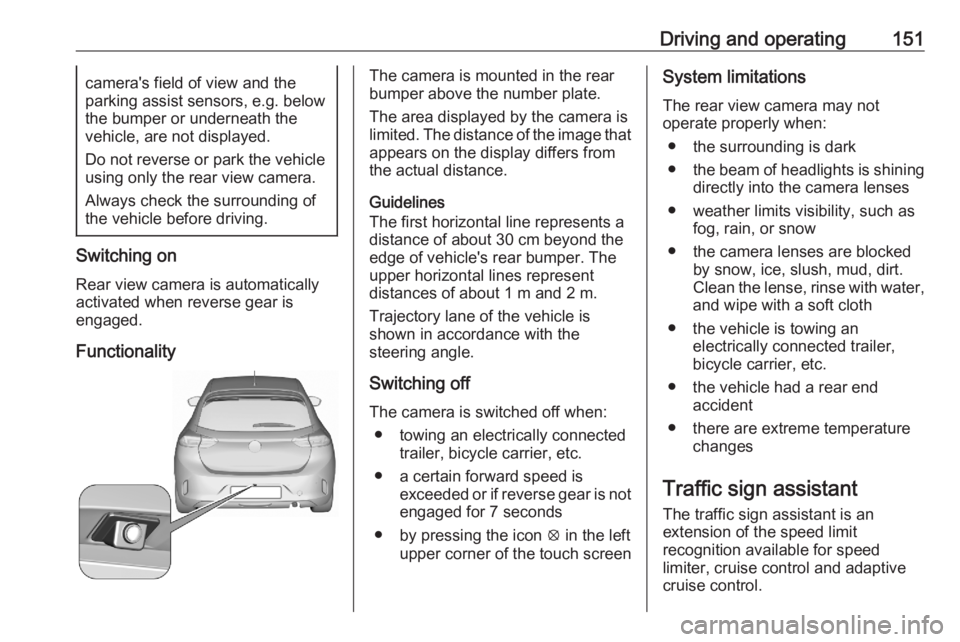
Driving and operating151camera's field of view and the
parking assist sensors, e.g. below
the bumper or underneath the
vehicle, are not displayed.
Do not reverse or park the vehicle using only the rear view camera.
Always check the surrounding of
the vehicle before driving.
Switching on
Rear view camera is automatically
activated when reverse gear is
engaged.
Functionality
The camera is mounted in the rear
bumper above the number plate.
The area displayed by the camera is
limited. The distance of the image that
appears on the display differs from
the actual distance.
Guidelines
The first horizontal line represents a
distance of about 30 cm beyond the
edge of vehicle's rear bumper. The
upper horizontal lines represent
distances of about 1 m and 2 m.
Trajectory lane of the vehicle is
shown in accordance with the
steering angle.
Switching off
The camera is switched off when: ● towing an electrically connected trailer, bicycle carrier, etc.
● a certain forward speed is exceeded or if reverse gear is not
engaged for 7 seconds
● by pressing the icon q in the left
upper corner of the touch screenSystem limitations
The rear view camera may not
operate properly when:
● the surrounding is dark
● the beam of headlights is shining
directly into the camera lenses
● weather limits visibility, such as fog, rain, or snow
● the camera lenses are blocked by snow, ice, slush, mud, dirt.Clean the lense, rinse with water,
and wipe with a soft cloth
● the vehicle is towing an electrically connected trailer,
bicycle carrier, etc.
● the vehicle had a rear end accident
● there are extreme temperature changes
Traffic sign assistant
The traffic sign assistant is an
extension of the speed limit
recognition available for speed
limiter, cruise control and adaptive
cruise control.
Page 154 of 229

152Driving and operating
The system recognises the traffic
signs above and displays them in the
Driver Information Centre.
9 Warning
The actual traffic sign always
takes priority over the traffic sign displayed in the Driver Information Centre.
If the vehicle enters a road of whichthe entry is prohibited, the no entry
traffic symbol and a warning message are displayed in the Driver
Information Centre. If the system
detects one of the other traffic signs,
the respective traffic sign is displayed
in the Driver Information Centre.
Speed limiter 3 122
Cruise control 3 120
Adaptive cruise control 3 124
Lane keep assist
Lane keep assist supports the driver
to avoid unintended leaving of the
lane. The front camera observes road
edges, as well as the lane markings
between which the vehicle is driving.
If the vehicle approaches a road edge or a lane marking, the steering wheel
is gently turned to position so that the
vehicle turns back into the lane. The
driver will then notice a turning
movement of the steering wheel. Turn steering wheel in same direction, if
the system does not steer sufficiently.
Turn steering wheel gently into
opposite direction, if lane change is
intended.
When the system steers to correct the trajectory of the vehicle, L flashes
yellow in the instrument cluster.
Unintended lane departure is not
assumed by the system when the turn lights are operated and during few
seconds after turn lights have been
switched off.Note
The system may be switched off if it
detects lanes which are too narrow,
too wide or too curved.
Following preconditions have to be
fulfilled:
● vehicle speed must be between 65 km/h and 180 km/h
● the driver must hold the steering wheel
● the turn lights are not activated
● the electronic stability control is activated and not in operation
● the vehicle is not connected to a trailer or an electric bicycle carrier
● normal driving behaviour (system
detects dynamic driving style, i.e. pressure on the brake or
accelerator pedal)
● roads with good lane markings ● no spare wheel is used
● the driver is not taking the hands off the steering wheel for a longer
time period
● the vehicle is not driven in a tight
corner
Page 215 of 229

Customer information213Siemensstrasse 12, 93055
Regensburg, Germany
Operation frequency:
90.0 - 119.0 MHz
Maximum output:
39.24dBµA/m @ 3m
Antenna module
Hirschmann Car Communication
GmbH
Stuttgarter Strasse 45-51, 72654 Neckartenzlingen, Germany
Operation frequency: N/A
Maximum output: N/A
ASK Industrie SpA
C.P. 110 c/o U.P. RE2, 42121 Reggio
Emilia, Italy
Operation frequency: N/A
Maximum output: N/A
Fiamm France - RCA Spa
12 rue Augustin Fresnel, 78420
Aubergenville, France
Operation frequency: N/A
Maximum output: N/AElectronic key transmitter
Valeo Comfort and Driving
Assistance
76, rue Auguste Perret 94046 Créteil
- CEDEX France
Operation frequency:
433.05 - 434.79 MHz
Maximum output: 10 dBm
Electronic key receiver
Valeo Comfort and Driving
Assistance
76, rue Auguste Perret 94046 Créteil - CEDEX France
Operation frequency: 125 MHz
Maximum output: -7.3 dBm
Radio remote control transmitter
Huf Hülsbeck & Fürst GmbH & Co.
KG
Steeger Str. 17, 42551 Velbert,
Germany
Operation frequency:
433.05 - 434.79 MHz
Maximum output: -14 dBm
Radio remote control receiver
Aptiv Services France SAS22 Avenue des Nations ZAC Paris Nord II 93420 Villepinte France
Operation frequency: 125 MHz
Maximum output: 66 dBμA/m at 10m
Immobiliser
Kostal Bulgaria Automotive
Pazardzhik
ul. "Sinitevska" 4, 4400 Southern
Industrial Zone, Bulgaria
Operation frequency: 119 - 134 kHz
Maximum output: 72 dBμA/m at 10m
Radar unit
ZF TRW Autocruise SAS
Secteur de la Pointe du Diable,
Avenue du technopôle, 29280
Plouzane, France
Operation frequency:
76.0 - 77.0 GHz
Maximum output: 28 dBm
BTA Module
Marelli S.p.A.
Viale A. Borletti 61/63, 20011
Corbetta, Italy
Page 224 of 229
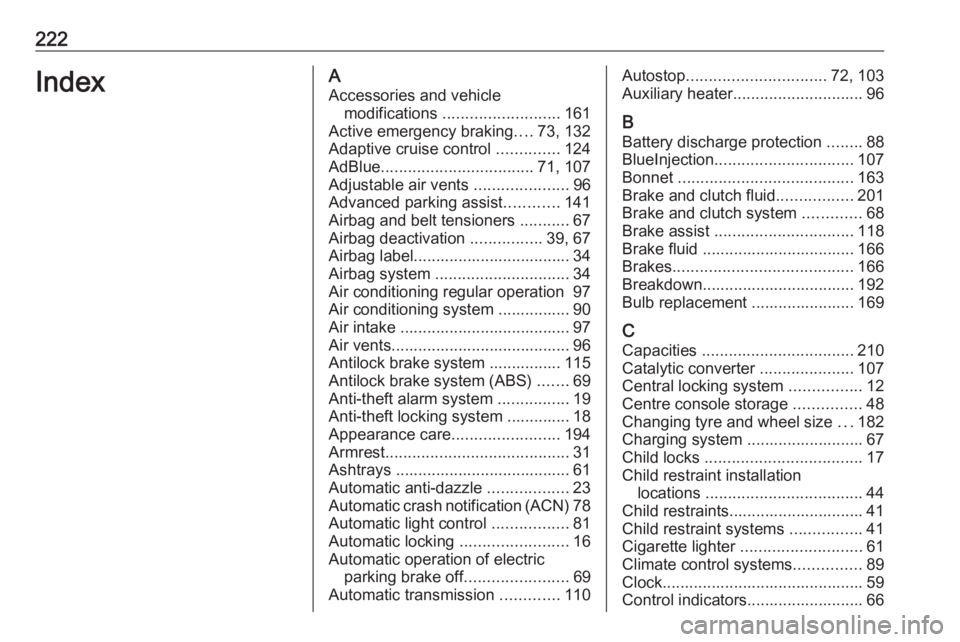
222IndexAAccessories and vehicle modifications .......................... 161
Active emergency braking ....73, 132
Adaptive cruise control ..............124
AdBlue .................................. 71, 107
Adjustable air vents .....................96
Advanced parking assist ............141
Airbag and belt tensioners ...........67
Airbag deactivation ................39, 67
Airbag label................................... 34 Airbag system .............................. 34
Air conditioning regular operation 97
Air conditioning system ................ 90
Air intake ...................................... 97
Air vents........................................ 96
Antilock brake system ................ 115
Antilock brake system (ABS) .......69
Anti-theft alarm system ................19
Anti-theft locking system .............. 18
Appearance care ........................194
Armrest ......................................... 31
Ashtrays ....................................... 61 Automatic anti-dazzle ..................23
Automatic crash notification (ACN) 78
Automatic light control .................81
Automatic locking ........................16
Automatic operation of electric parking brake off .......................69
Automatic transmission .............110Autostop............................... 72, 103
Auxiliary heater ............................. 96
B Battery discharge protection ........88
BlueInjection ............................... 107
Bonnet ....................................... 163
Brake and clutch fluid .................201
Brake and clutch system .............68
Brake assist ............................... 118
Brake fluid .................................. 166
Brakes ........................................ 166
Breakdown.................................. 192
Bulb replacement ....................... 169
C Capacities .................................. 210
Catalytic converter .....................107
Central locking system ................12
Centre console storage ...............48
Changing tyre and wheel size ...182
Charging system .......................... 67
Child locks ................................... 17
Child restraint installation locations ................................... 44
Child restraints.............................. 41
Child restraint systems ................41
Cigarette lighter ........................... 61
Climate control systems ...............89
Clock............................................. 59
Control indicators.......................... 66
Page 225 of 229
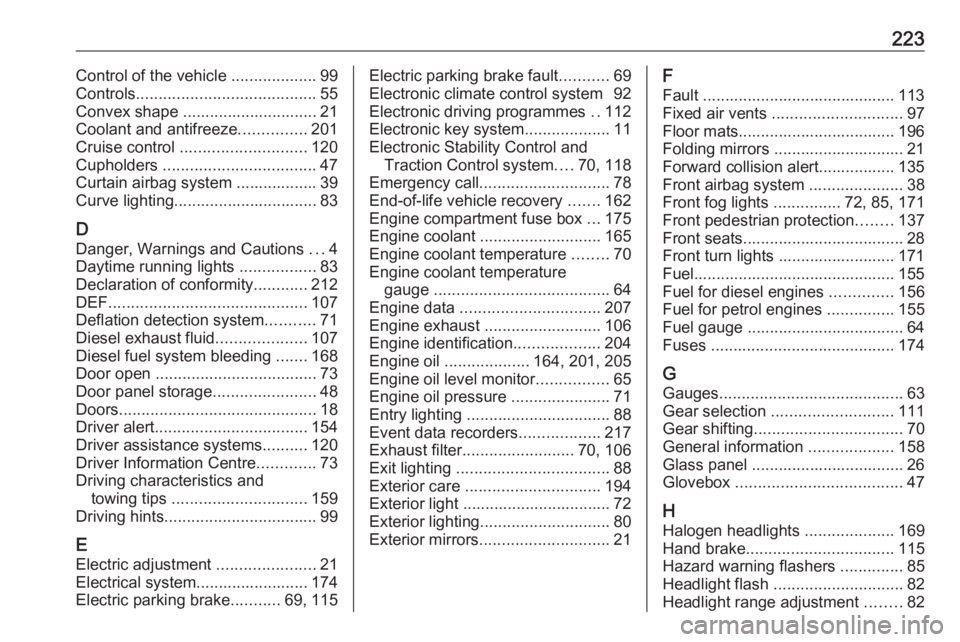
223Control of the vehicle ...................99
Controls ........................................ 55
Convex shape .............................. 21
Coolant and antifreeze ...............201
Cruise control ............................ 120
Cupholders .................................. 47
Curtain airbag system .................. 39
Curve lighting................................ 83
D Danger, Warnings and Cautions ...4
Daytime running lights .................83
Declaration of conformity ............212
DEF ............................................ 107
Deflation detection system ...........71
Diesel exhaust fluid ....................107
Diesel fuel system bleeding .......168
Door open .................................... 73
Door panel storage .......................48
Doors ............................................ 18
Driver alert .................................. 154
Driver assistance systems ..........120
Driver Information Centre .............73
Driving characteristics and towing tips .............................. 159
Driving hints .................................. 99
E
Electric adjustment ......................21
Electrical system......................... 174
Electric parking brake ...........69, 115Electric parking brake fault ...........69
Electronic climate control system 92
Electronic driving programmes ..112
Electronic key system ...................11
Electronic Stability Control and Traction Control system ....70, 118
Emergency call ............................. 78
End-of-life vehicle recovery .......162
Engine compartment fuse box ...175
Engine coolant ........................... 165
Engine coolant temperature ........70
Engine coolant temperature gauge ....................................... 64
Engine data ............................... 207
Engine exhaust .......................... 106
Engine identification ...................204
Engine oil ................... 164, 201, 205
Engine oil level monitor ................65
Engine oil pressure ......................71
Entry lighting ................................ 88
Event data recorders ..................217
Exhaust filter ......................... 70, 106
Exit lighting .................................. 88
Exterior care .............................. 194
Exterior light ................................. 72
Exterior lighting ............................. 80
Exterior mirrors ............................. 21F
Fault ........................................... 113
Fixed air vents ............................. 97
Floor mats................................... 196
Folding mirrors ............................. 21
Forward collision alert................. 135
Front airbag system .....................38
Front fog lights ...............72, 85, 171
Front pedestrian protection ........137
Front seats.................................... 28
Front turn lights .......................... 171
Fuel............................................. 155
Fuel for diesel engines ..............156
Fuel for petrol engines ...............155
Fuel gauge ................................... 64
Fuses ......................................... 174
G Gauges ......................................... 63
Gear selection ........................... 111
Gear shifting ................................. 70
General information ...................158
Glass panel .................................. 26 Glovebox ..................................... 47
H Halogen headlights ....................169
Hand brake ................................. 115
Hazard warning flashers ..............85
Headlight flash ............................. 82
Headlight range adjustment ........82